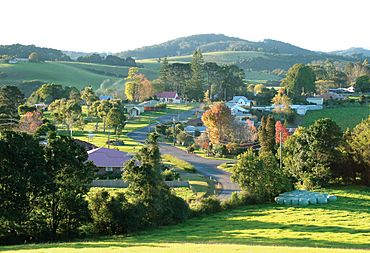Comboyne, New South Wales facts for kids
Quick facts for kids ComboyneCamden Haven, New South Wales |
|||||||||||||||
|---|---|---|---|---|---|---|---|---|---|---|---|---|---|---|---|

Comboyne is located on the Comboyne Plateau, an area of rolling hills characterised by red basalt soils and high rainfall.
|
|||||||||||||||
| Population | 416 (2021 census) | ||||||||||||||
| Postcode(s) | 2429 | ||||||||||||||
| Elevation | 588 m (1,929 ft) | ||||||||||||||
| Location |
|
||||||||||||||
| LGA(s) | Port Macquarie Hastings | ||||||||||||||
| State electorate(s) | Oxley | ||||||||||||||
| Federal Division(s) | Lyne | ||||||||||||||
|
|||||||||||||||
|
|||||||||||||||
Comboyne is a small village located on the Mid North Coast of New South Wales, Australia. It sits on a high area called the Comboyne Plateau. This area is known for its rich, fertile soil and lots of rain, making it great for farming.
The name "Comboyne" comes from the local Birpai (or Biripi) people. Their word for this place, "Gambuyn," means "a place of kangaroos." The Birpai people have lived here for over 40,000 years.
In 2021, about 416 people lived in Comboyne. The village is about 60 kilometers southwest of Port Macquarie. It is also 35 kilometers west of Kew and 54 kilometers northwest of Taree.
Comboyne's Natural Environment
Comboyne was once covered in thick sub-tropical rainforest. Most of this forest was cleared by the early 1900s. Early explorers came here looking for valuable timber, especially the Australian Red Cedar.
Protecting Nature
Today, some of the original rainforest is protected. The Boorganna Nature Reserve is nearby and is the second oldest nature reserve in New South Wales. It helps save a part of the sub-tropical rainforest. You can also find the rare Antarctic beech trees in four spots around Comboyne.
Land and Weather
Comboyne gets a lot of rain, about 1818 millimeters each year. Even though it's in a sub-tropical area, it's cooler than the coast. This is because Comboyne is high up, about 588 meters above sea level.
How the Land Formed
The soil in Comboyne is a deep red color. It comes from basalt rock, which makes the soil very fertile. This basalt came from the Comboyne Shield Volcano, which erupted a very long time ago, about 11 to 13 million years ago.
Below the basalt, there are older, less fertile rocks. The Comboyne Plateau is a flat area with steep edges. It sits between the central north coast of New South Wales and the Great Dividing Range.



